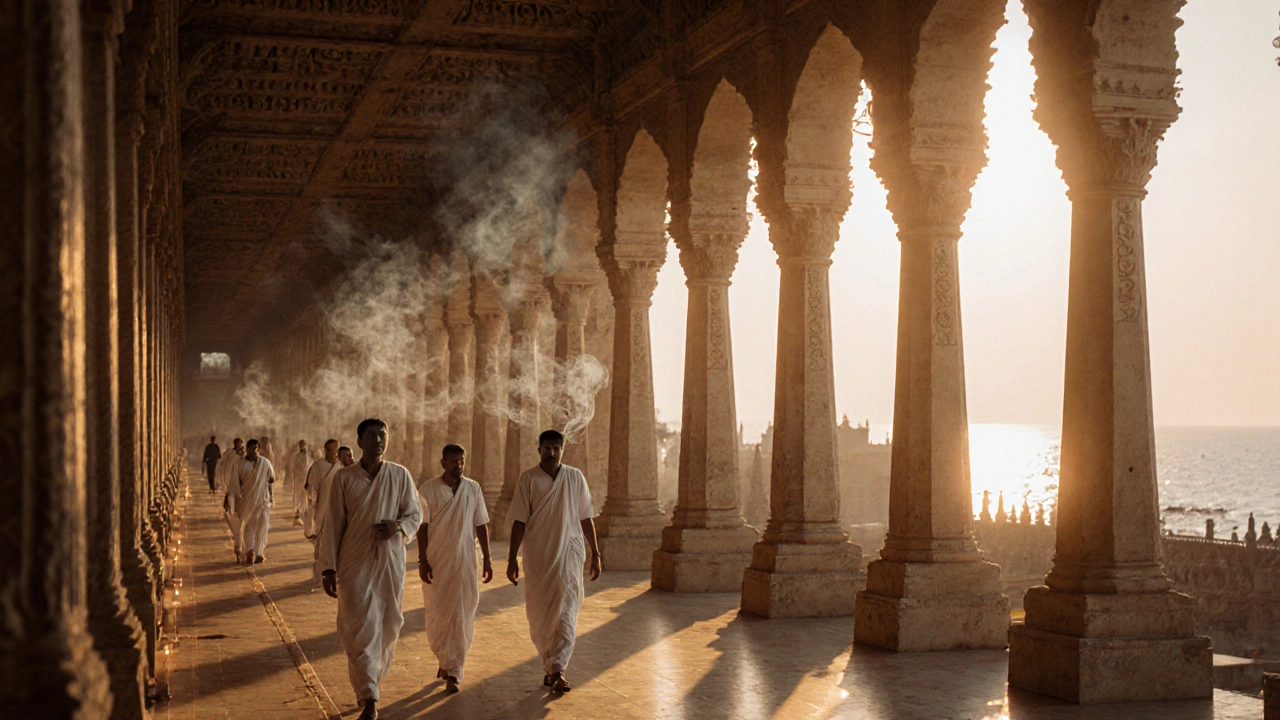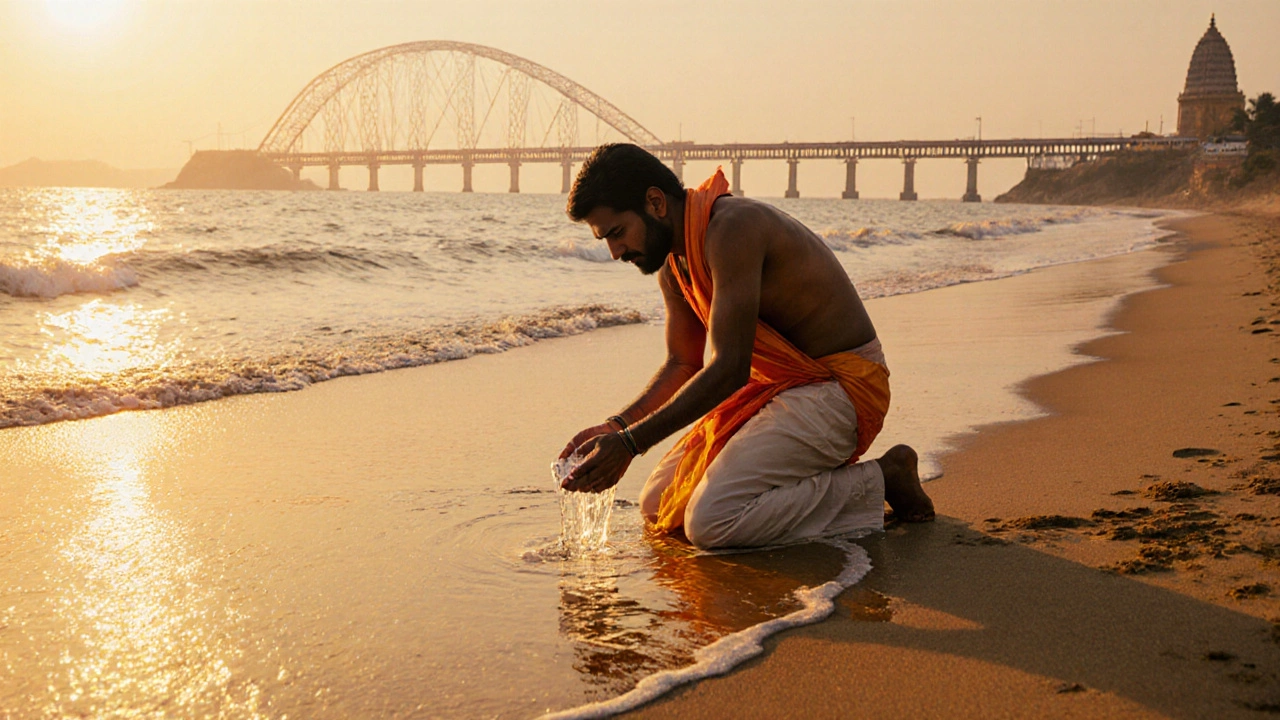How Many Days Are Required to Visit Rameshwaram? A Practical Guide

- Oct, 30 2025
- 0 Comments
- Aaron Blackwood
Rameshwaram Visit Duration Calculator
How Many Days Do You Need?
Based on your interests and travel style
Your Visit Profile
Recommended Visit Duration
Why this recommendation:
Most people assume Rameshwaram is a quick stop on a South India pilgrimage route-just a few hours to see the temple and move on. But if you want to truly feel the spiritual weight of this place, you need more than a day. Rameshwaram isn’t just a temple. It’s a living tapestry of myth, devotion, and coastal calm that unfolds slowly. The question isn’t just Rameshwaram temple visit-it’s how deeply you want to connect with it.
One Day Is Barely Enough
You can technically see the main Ramanathaswamy Temple in six hours. Arrive by 8 a.m., walk through the longest corridor in India (1,212 pillars), light a lamp, and leave by 2 p.m. But you’ll miss everything else. The temple’s energy doesn’t peak at noon. It builds through the day as pilgrims chant, priests perform rituals, and the sea breeze carries the scent of jasmine and incense. If you leave before sunset, you won’t feel why this place is called the ‘Kashi of the South’.Most travelers skip the 22 holy wells-each linked to a different episode from the Ramayana. You won’t know why locals say drinking water from Jaya and Vijaya kunds cleanses sins unless you stand there, quiet, watching others cup their hands and sip. And you’ll never understand the rhythm of Rameshwaram if you don’t sit on the beach as the sun dips behind the Gulf of Mannar, hearing the distant sound of temple bells mixed with waves.
Two Days: The Minimum for Meaning
Two full days is the sweet spot for most visitors. Here’s how it breaks down:- Day 1: Morning temple visit with the first arati (around 5:30 a.m.). Walk the corridors. Visit the 22 kunds. See the sacred lingam made of sand, believed to be installed by Lord Rama himself. Afternoon: Visit Dhanushkodi, the ghost town swallowed by a cyclone in 1964. The broken railway station, rusted train cars, and empty streets feel like stepping into a forgotten world.
- Day 2: Sunrise at Agni Theertham-the beach where Lord Rama is said to have prayed before crossing to Lanka. Then, take a boat ride to the nearby islands. Stop at Pamban Bridge, the first sea bridge in India, and watch trains cross over the waves. End the day with a quiet evening at the temple, when the crowd thins and the chants echo louder.
Two days lets you breathe. You’ll notice how pilgrims from Tamil Nadu, Kerala, and even Karnataka arrive with offerings of coconuts, turmeric, and silk. You’ll see the difference between those rushing through and those who sit for hours, eyes closed, just listening.
Three Days: For the Devout and the Curious
If you’re here for more than sightseeing-if you want to understand why Rameshwaram is one of the Char Dham pilgrimage sites-then three days is ideal. Add these layers:- Day 3: Visit the Kothandaramaswamy Temple, just 5 km away. It’s smaller, quieter, and holds a unique statue of Rama, Sita, and Lakshmana together-rare in South Indian temples. Then, meet local priests. Many have served here for generations. Ask about the daily rituals, the meaning behind the 108 lingams in the inner sanctum, or why the temple’s water is considered as pure as the Ganges.
- Take a guided walk through the old town. The narrow lanes are lined with families who’ve lived here for centuries, selling handmade sandalwood beads, temple bells, and printed hymns. You’ll find shops where the same family has sold the same type of flower garland since the 1940s.
Three days lets you see Rameshwaram not as a tourist spot, but as a community. It’s a place where faith is lived, not performed. You’ll realize why people return here year after year-not for the architecture, but for the silence between the chants.

What You’ll Miss If You Rush
People who stay less than two days often say, “It’s just a temple.” But they miss the details that make it sacred:- The sound of the temple’s brass bells ringing every 15 minutes-each one tuned to a different note, creating a natural melody.
- The way the sand at Agni Theertham turns golden at sunset, just like the descriptions in the Ramayana.
- The quiet moment when the priest removes the temple’s main lingam for cleaning, and only a few devotees are allowed to touch it.
- The smell of wet stone after evening prayers, mixed with the salt of the sea.
These aren’t tourist facts. They’re sensory memories. And you can’t collect them in a hurry.
Seasonal Considerations
The best time to visit is between October and March. The weather is cool, the sea is calm, and the temple is less crowded. Avoid April to June-temperatures hit 38°C and the humidity makes walking unbearable. July to September brings monsoon rains, which can flood streets and delay boat rides.If you’re visiting during the annual Rama Navami festival (March-April), expect crowds so thick you’ll need patience. But you’ll also witness processions with elephants, live recitations of the Ramayana, and thousands lighting lamps along the beach. It’s unforgettable-but you’ll need at least four days to handle the chaos and still find peace.

How to Plan Your Trip
- Arrival: Fly into Madurai (170 km away) or take a train to Rameshwaram station. Both are well-connected to major cities. - Stay: Choose a guesthouse near the temple. Most offer simple rooms with rooftop views of the sea. Avoid luxury hotels-they’re out of place here. - Food: Eat at the temple’s free community kitchen (annadanam). It serves hot rice, sambar, and curd rice daily. It’s the most authentic experience you’ll have. - Dress: Cover your shoulders and knees. Men must remove shirts before entering the inner sanctum. Women should wear sarees or salwar kameez.Final Thought: It’s Not About Time, It’s About Presence
You don’t need a week in Rameshwaram. But you do need to stop rushing. Two days is enough to see the temple. Three days is enough to feel it. If you come here thinking it’s just another stop on your India itinerary, you’ll leave unchanged. But if you come with quiet curiosity, you’ll carry a piece of Rameshwaram with you long after you’ve left.Can I visit Rameshwaram in one day?
Yes, you can physically visit the main temple in one day, but you’ll miss the deeper experience. You won’t have time to explore Dhanushkodi, the 22 holy wells, or Agni Theertham at sunset. A one-day visit feels rushed and superficial. If you’re on a tight schedule, prioritize the temple and one beach site-but know you’re not getting the full picture.
Is Rameshwaram worth visiting if I’m not religious?
Absolutely. Even if you’re not religious, Rameshwaram offers something powerful: history, architecture, and a rare sense of stillness. The temple’s corridors are engineering marvels. Dhanushkodi is a hauntingly beautiful ghost town. The sea views are stunning. Many non-religious travelers say the quiet atmosphere, the rhythm of daily rituals, and the kindness of locals make it one of the most moving places they’ve visited in India.
What’s the best time of day to visit the Rameshwaram temple?
Go early-before 7 a.m. The temple opens at 5:30 a.m. with the first arati, and the atmosphere is peaceful. By 10 a.m., crowds build. Late afternoon, after 4 p.m., is also good-fewer people, cooler air, and the golden light makes the marble glow. Avoid midday when it’s hot and packed.
Can I combine Rameshwaram with other South Indian temples in one trip?
Yes, Rameshwaram fits perfectly into a South India temple circuit. It’s about 3.5 hours from Madurai (home to Meenakshi Temple) and 5 hours from Kanyakumari (where the Indian Ocean meets the Bay of Bengal). Many travelers do a 5-day loop: Madurai → Rameshwaram → Kanyakumari → Trivandrum. Just allow at least two full days for Rameshwaram itself-don’t rush it.
Are there any restrictions for foreign visitors at the Rameshwaram temple?
Foreign visitors are welcome, but access to the inner sanctum is restricted to Hindus only. Non-Hindus can view the temple from the outer corridors and the main courtyard. Dress modestly, remove footwear before entering, and follow the crowd’s lead. Most locals are welcoming and will help you understand what’s allowed. Don’t try to take photos inside the main shrine-it’s strictly prohibited.